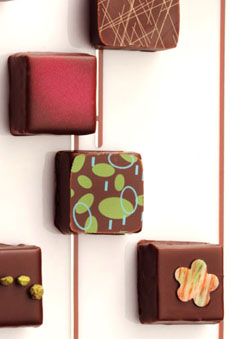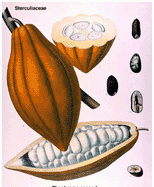 
These gorgeous bonbons from Jin Patisserie of Venice, California, a NIBBLE Top Pick Of The Week, bear zero resemblance to the chocolate first experienced by the Spanish Conquistadors. These: among the most delicious confections in America, are filled with fondant flavors like Ginger, Green Jasmine, Lemongrass and Roasted Black Sesame. The original chocolate was also exotic, but a bitter, unsweetened beverage mixed with pepper, chili pepper, musk, vanilla and cornmeal. It was enjoyed by the Aztecs but so unpalatable to the Europeans, they spat it on the ground.
|
KAREN HOCHMAN’s first word was not cacahuatl...but as her mother will attest, it was pretty close.
|
|
August 2005
Updated January 2009
|
 |
From Pod to Palate Part I: A Brief History Of Chocolate
Page 2: Introduction
This is Page 2 of a four-page article. Click on the black links below to visit other pages.
Meanwhile, Back in the Rainforest...
Caco Is Cultivated By The Olmecs, Maya & Aztecs
The words cacao and chocolate come from our ancient neighbors in Central America, who first sampled its joys. Cacao trees, which originated in the Amazon region, grew wild in the rainforests of ancient Mexico. They were cultivated by the native Olmecs and the Mayas who followed them. While the sweet white fruit of the cacao pod was initially sought by the Amazonian natives, they ultimately found that grinding and mixing the seeds with water produced an even greater treat.
Mankind has been enjoying chocolate for millennia: We know that more than 2500 years the Maya were making the cacao beverage; and perhaps as early as 1200 B.C.E. the Olmec were doing so. The Maya believed that the cacao tree its fruit were a gift of the gods; the tree was worshipped as a symbol of fertility and life. Elaborately decorated drinking vessels almost 2000 years old have been found illustrating chocolate ceremonies—and still containing traces of chocolate. Note the reference to drinking vessels: Chocolate has been a beverage for most of its history, as you’ll discover shortly. Cacao beans were so precious, they were used as currency: a turkey cost 200 beans, a tomato, 3 beans.
Called xocoatl by the Mayas and cacahuatl by the Aztecs, chocolate was a ritual beverage on the Yucatan, reserved for the nobility, priests, high officials, warriors and rich traders, who believed it to have restorative and aphrodisiac powers. The Aztec developed a taste for chocolate after trading with their Mayan neighbors to the south. Montezuma used it as a medicinal revitalizer, believing it nourished strength, stimulated potency and fertility, and abetted longevity.

A cacao pod, fruit, and seeds.
Hardly the sweet treat we know today, xocoatl was served as a cold, unsweetened drink—beans crushed into a paste and whipped until foamy with pepper, vanilla, chili pepper, cinnamon, musk and cornmeal. Still, it was fatty and bitter; the foam was considered to be the best part. Christopher Columbus and his officers, offered the elixir as a great honor, found the bitter concoction unpalatable and couldn’t even choke it down. He had no idea the locals were offering him their most valuable goods for trade. Thinking the product abominable, he brought only a few beans back to Spain. Seventeen years later, Hernan Cortés understood its value, and promoted plantations run by Europeans. Today’s descendants of the Maya and Aztec still prepare cacao and corn-based drinks that are similar to those enjoyed by their ancestors.
According to Michael D. Coe, Professor Emeritus of Anthropology at Yale University, history is incorrect in crediting the Spanish conquistador Hernán Cortès for recognizing the potential of cacao upon his arrival in 1509. According to Professor Coe in a presentation at the University of Guatemala about chocolate in Guatemalan culture, neither Cortès nor Christopher Columbus had anything to do with it. Rather, it was a delegation of Kekchi Maya nobles from Alta Verapaz who introduced the beverage drink to the Spanish court. However, when when Cortès returned to Spain in 1527, he brought back beans. You can read more of the presentation by clicking here. Some sources credit the nuns of Oaxaca, Mexico with being the first to add sugar to the bitter cacao, making it a palatable drink. Sugar was unknown in the New World: Both sugar, and later honeybees, were brought by Europeans.
Continue To Page 3: Cacao Comes To Europe
Go To The Article Index Above

|





